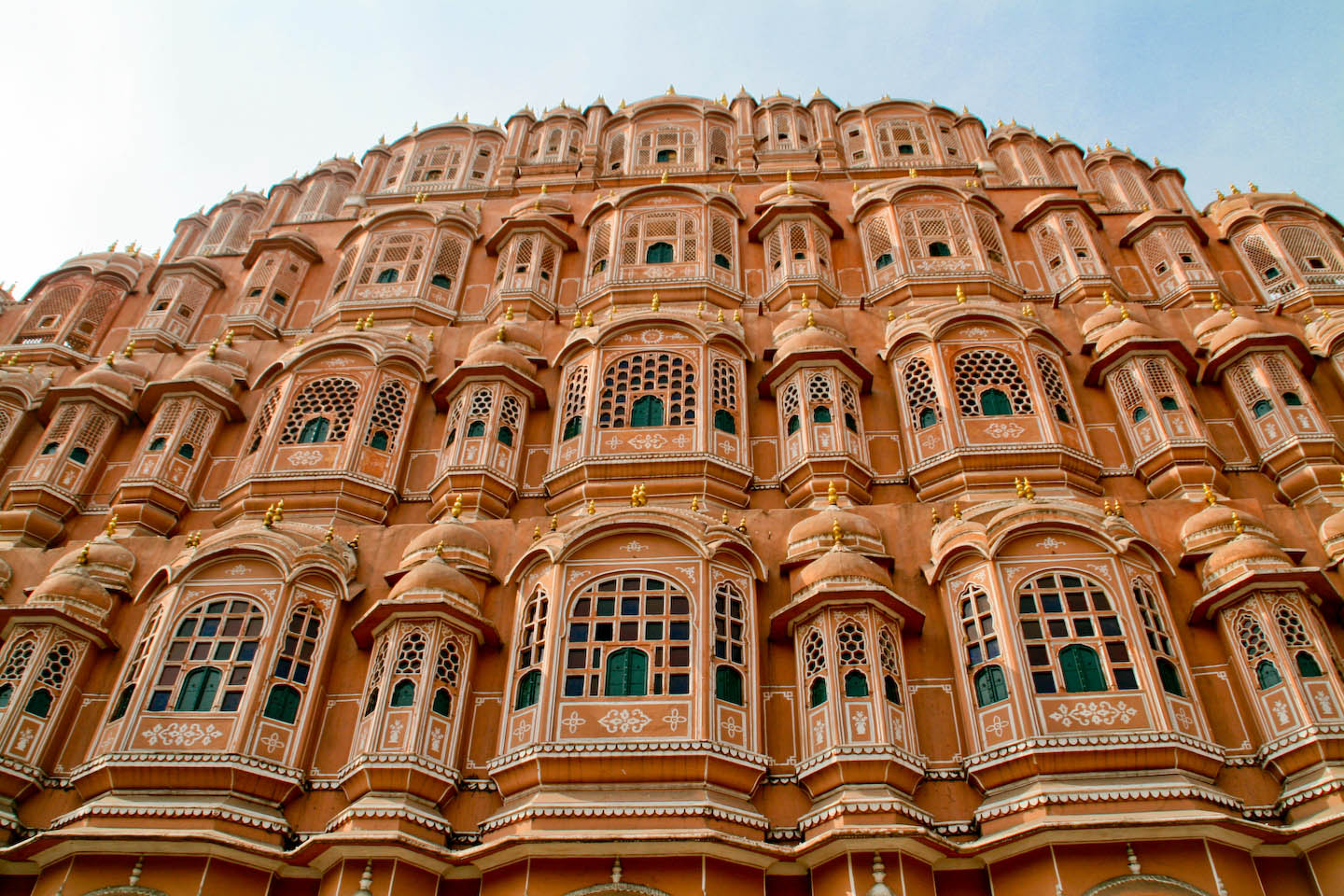 |
|
 |
|
Pink City Jaipur
 Jaipur is 260 km from Delhi and 240 km from Agra andjaipur, pink city, capital city of state Rajasthan, hawa mahal ... forms the golden triangle of Delhi, Agra and Jaipur. It a bustling capital city and a business centre with all the trappings of a modern metropolis but yet flavoured strongly with an age-old charm that never fails to surprise a traveller. The old Jaipur painted in Pink can grip any visitor with admiration. Stunning backdrop of ancient forts: Nahargarh, Amer, Jaigarh and Moti Doongari are apt testimonials of the bygone era and a reminder of their lingering romance and chivalry.
Jaipur is named after its founder, the warrior and astronomer sovereign, Maharaja Sawai Jai Singh (ruled 1688 to 1744). The decision to move out of his hilltop capital Amer was also compelled by reasons of growing population and paucity of water. Moreover in the early 17th century the power of the great Mughals was dwindling with its aging Monarch Aurangzeb. After several centuries of invasions the north was now quiet and the wealth of the kingdom had considerably increased. Seizing upon this opportune time, Jai Singh planned his new capital in the plains. Jaipur is a corroborative evidence of Sawai Jai Singh's strong grounding in science and astrology and of a Bengali architect Vidyadhar with a strong instinct for planning.
City palace
Located in the heart of the walled city, the City Palace Complex gives you an idea about the farsightedness of the founder of Jaipur Maharaja Sawai Jai Singh. He left behind a legacy of some of the most imposing and magnificent architecture in the city. Maharaja Sawai Jai Singh built many buildings but some of the structures were also built by later rulers. The palace is a blend of Mughal and Rajput architecture and the ex-royal family still lives in a part of the palace.
On entering the complex and before the proper palace lies the Mubarak Mahal, the palace of welcome or reception. Maharaja Sawai Madho Singh built the palace in the nineteenth century. It was used as a reception centre for the visiting personage. The building now forms the Maharaja Sawai Man Singh II Museum and on display here are a wide array of royal costumes, some very exquisite and precious Pashmina (Kashmiri) shawls, Benaras silk saris, Sanganeri prints and folk embroidery. An unusual display is that of voluminous clothes worn by Maharaja Sawai Madho Singh I (ruled 1750-68).
The Maharani's Palace, the palace of the Queen paradoxically puts on a display of the Rajput weaponry. The inestimable collections of weapons date back to even 15th century and are in a remarkable state of preservation. Remarkable amongst them is scissor-action dagger. This deadly weapon were so designed that the handles were released to spread the blades when thrust into bodies. The dagger was then withdrawn fatally tearing limb to limb of the body of the hapless victim. Other exhibits include protective chain armours, pistols, jewelled and ivory handled swords, a belt sword, small and assorted cannons, guns, poison tipped blades and gun powder pouches. The frescoes on the ceiling are amazing and well preserved.
Timings : Duration of Openings (Hrs.): 9.00-17.00
Albert hall
Located just outside the walled city is the sprawling Ram Niwas garden, which has always been a place for recreational activities since the reign of Maharaja Sawai Ram Singh. This exquisitely designed garden with four sentry doors and a huge complex with small pools and fountains, flourishing lawns and beautiful flower beds all around was basically a famine relief project. It mostly attracted the British families where they entertained their guests and families quite often with the elaborate gowns of the women and formal colourful attires of the nobles and the high society club members. This park would come alive with the setting sun. Their individual 'Baggis'( horse carriages) were parked outside in a line and the attendants were at the beck and call. The children had a gala time playing around on 'jhulas'(swing) etc. During day time it was opened for the common public and by evening it was available for the exclusive lot.
Situated in the middle of the garden as the centre of attraction is the exquisitely built structure of Albert Hall. It was designed by Sir Swinton Jacob, a British architect who designed many palaces in Rajasthan. Combining the elements of English and north Indian architecture – it was known as the pride of the New Jaipur when it opened in 1887 AD. it is a very well maintained and impressive building displaying a rich collection of artefacts like paintings, carpets, ivory, stone, metal sculptures, colourful crystal works etc. The Albert Hall museum undergoing renovation. Right opposite the Albert Hall is one of the oldest zoos in the country, harbouring different species of birds and animals. Another piece of attraction near Albert Hall is the Ravindra Rang Manch (theatre) with a modern art gallery and a performing arts theatre, both indoor and open air.
Timings :
Duration of Openings (Hrs.): 9.00-17.00
Moti Dungri and Ganesh Temple
In the middle of Jaipur is a small hill Moti Dungri meaning pearl hill, because it looks like a drop of pearl. An exotic palace is perched atop the hill which is a replica of a Scottish castle once occupied by Maharaja Sawai Man Singh. From there on, it remained a private property of the royal family. In the recent past it served as a home for Rajmata Gaytri Devi's only son, the late Jagat Singh. The mere view of this castle is exotic enough. The highlight of this place is the famous and auspicious temple of Lord Ganesh, which is situated at the hill. It is frequented by Jaipurites on religious occasions.
Hawa Mahal
The poet king Sawai Pratap Singh built this palace of winds. This is easily the most well-known landmarks of Jaipur and is also its icon. Located in the City Palace complex, it is best viewed from the road outside. This five-storey building overlooking the busy bazaar street is a fascinating example of Rajput architecture and artistry with its delicately honeycombed 953 pink sandstone windows known as 'jharokhas'. It was originally built for the ladies of the royal household to watch everyday life and processions in the city from their veiled comfort.
Most people come here to get a view of the facade but they can also climb to the top for a wonderful view from the latticed windows. There is also a small archaeological museum there.
Timings :
Duration of Openings (Hrs.): 9.00-16.30
Gaitore
It is the final resting place of the Maharajas of Jaipur and is located just off the Jaipur - Amber Road. Situated in a narrow valley the cenotaphs of the former Maharajas are made in typical Rajput architectural style. The chhatri of Maharaja Sawai Jai Singh is of special mention for its carvings.
Jaigarh Fort
The Jaigarh fort is the most spectacular of the three-hilltop forts that overlook Jaipur. In Mughal times, the Jaipur region was a major weapon-producing centre for the Mughal and Rajput rulers, several of the weapons being on display in the fort's museum. It is one of the few military structures of medieval India preserved almost intact, containing palaces, a granary, a well-planned cannon foundry, several temples, a tall tower and giant mounted cannon-the Jai Ban (Jaivan) which is the largest cannon on wheels in the world. Jaigarh Fort is also known as the fort of victory. The display includes a collection of canons, many of which are exquisitely decorated and were used in the Mughal campaigns led by the Rajput King, Raja Man Singh.
Of Jaipur's three forts, Jaigarh is perhaps the most imposing. It does not have those delicate structures or palaces like that of Amber but if you want a quick look at a hard-core fortress, this is it. Jaigarh means `Victory Fort' and was built between the 15th and the 18th century AD, and stands 15 km from Jaipur, amidst rock-strewn, thorn-scrub covered hills, its forbidding stone ramparts being visible from the Jaipur town. A steep road goes up to the main gate, the Dungar Darwaza, from where the view is are inspiring.
Timings :
Duration of Openings (Hrs.): 9.00-16.30
Nahargarh Fort
Nahargarh Fort is located on the rugged ridge of Aravali Hills and it forms an impressive northern backdrop of Jaipur. It looks most classy when floodlit at night. The fort overlooks the city and presents a glittering view of the city lights. It was built in 1734 and extended in 1868. Nahargarh meaning abode of the tigers was built by Jai Singh to bolster the defence of Amber. The legend has it that it was named Nahargarh after Nahar Singh, a prince whose spirit would destroy the construction and stall its progress. So after a tantrik invoked the spirit, it agreed to withdraw on condition that the fort would be named after him. The Madhavendra Bhawan, built by Sawai Madho Singh has a unique cluster of 12 identical suites for queens and at the head is a suite for the king himself. The rooms are linked by corridors and retain some delicate frescoes as well as toilets and kitchen hearths. It was used by members of the royal family for excursion in summers and is even now a favoured picnic spot. Durg Cafeteria just above the entrance sells meals and refreshments, while Padao Restaurant on the west sells drinks around sunset.
Timings :
Duration of Openings (Hrs.): 10.00-17.30
Amber Palace
Amber (pronounced Amer) is situated about 11 kilometres from Jaipur and was the ancient citadel of the ruling Kachwahas of Amber, before the capital was shifted to the plains, the present day Jaipur.
The Amber Fort set in picturesque and rugged hills is a fascinating blend of Hindu and Mughal architecture. Constructed by Raja Man Singh I in 1592 and completed by Mirja Raja Jai Singh the fort was made in red sand stone and white marble. The rugged forbidding exterior belies an inner paradise with a beautiful fusion of art and architecture. Amber is the classic and romantic fort-palace with a magnificent aura. The interior wall of the palace depicts expressive painting scenes with carvings, precious stones and mirror settings. In the foreground is the Maota Lake providing a breathtaking vista. Built mainly for the warring enemies as a safe place, the heavily structured walls could defend the residents within the ramparts of the fort.
All means of survival and luxuries for the royal families and the people who were concerned with the functioning of this small kingdom of the Kachhawas were well provided. The Rajputs who had apparently won a small structure passed on by Meena tribes, later on renovated it into the grand Amber Fort. Holding a history as old as seven centuries, this place vibrates with its legendary past. Although many of the early structures have been literally ruined but at the same time, those dating from 16th century onwards are remarkably well preserved by sincere efforts.
Timings :
Duration of Openings (Hrs.): 8.00-17.30
See Also Haripurdhar Travel guide, Kheerganga Trek, Trekking Near Kasol, Activitities to do near kasol, kasol travel, Theog Travel Guide, Kasol Travel Guide How to visit Kasol, mini israeil in india, gateway to heaven, Weekend Getaways to Visit near Delhi , Tawang Travel Guide, Reckong Peo travel guide Reckong Peo hotels, Off beat Places near Shimla, Tourists places near shimla, Kalpa Travel Guide, Keylong Travel Guide, Joginder Nagar, Hamirpur, ManiMahesh, Trout Fishing in Rohru, Khara Pathar - Pabbar Valley, Kollam, Fort Kochi, Munnar The Hill station of Kerela, Bharmaur - Land of legendary Gaddies, Chattradi, Historical fort of Kangra, Masroor Rock-cut Temple, Pragpur heritage village, village tourism in pragpur, Lansdowne A Weekend Retreat, Rewalsar, Sarahan, kasauli , Dagshai - one of the oldest cantonment towns of Himachal Pradesh, Kaza Travel Guide Places to visit in Kaza, Karsog Travel Guide, Jantar Mantar Travel Guide Jaipur, Pink City Jaipur, Bharatpur Rajasthan Travel Guide, Bundi Travel Guide, Bikaner Travel Guide, Ajmer Travel Guide, Alwar Travel Information, Kashmir The Paradise on Earth, PAHALGAM The Valley of Shepherds, Gulmarg Travel Guide, Sonamarg The Meadow of Gold, Hangrang Valley Travel Guide, Charang Ghati Travel Guide, Nako Lake Travel Guide, Bhangal, Mcleodganj Travel Guide, Gushaini Travel Guide, Dashir Lake, Bhrigu Lake, Narkanda A Tourist Destination Of The British Times, Kasauli Tourists Attraction, Barot Travel Guide, places to visit near mandi, how to visit barot, Shoghi Travel Guide, Salogra Trekking Ecstasy, Rohru Travel Guide, Fagu, Bhandal Valley, Saho Travel Guide, Sarol Picnic Spot Near Chamba, Salooni Chamba Travel Guide, Nahan Shivalik Hills Gems, Places to visit in Sirmour, Sirmour, Tourist Places near kinnaur, Kinnaur, Bharmaur Kugti Udaipur Manali trek, Maidi to Nadaun Trek, Hamirpur- Deotsidh- Sri Naina Devi Trek, Kinner Kailash Parikrama Trek , Manali Hamya Herbal Trek, Morchella Trek, Dharamsala Chhota Bhangal over sari Pass Kullu, Wild Trek Kullu Valley, Chander Trail kullu Valley, Malana History Trek Kullu Valley, Hamta Trek Kullu Valley, Trekking routes in Himachal, Trout Fishing in Himachal Pradesh, Paragliding in Bir Billing, Shimla Travel Guide, Deotsidh Temple Cave temple of Baba Balak nath, SujanPur Tihra Travel Guide, Kungri Gompa Travel Guide, Dhankar monastery, Kunzum Pass Travel Guide, Kaza Spiti Travel Guide, Kibber-Khyipur, Chander Taal Travel Guide, Spiti Valley Travel Guide, Baijnath ancient Shiv temple, Palampur City of Tea Gardens, Tourist Places in himachal pradesh, Places of tourists interest near dharamshala, Dharamshala Travel Guide, Mysterious Skeleton Lake of Roopkund, Thanedar Famous For Apple Gardens, Kufri Travel Guide, Ranikhet Tourism Ranikhet Travel Guide, Naldehra, Tattapani Travel Guide, Great Himalayan National Park, Chamba Beautifull Valley of Himachal, Renukaji, how to visit renuka lake, tour to renukaji, Chail Travel Guide, Khajjiar The mini Switzerland of India, Dalhousie hill station full of colonial charm, Rajgarh The Peach Valley, Adventure Sports in Manali, Manali Travel Guide, Jim Corbett National Park Tourism Guide, Champawat Rich in Heritage and culture, Bhowali one of the picturesque towns of Nainital, Barkot Travel Guide, Yamunotri Travel Guide, Tehri Garhwal Travel Guide, Sattal Travel Guide, Roopkund Travel Guide, Rajaji National Park Tourism and Travel Guide, PINDARI GLACIER TREKKING GUIDE, Naukuchiatal Lake Travel Guide, Nainital Tourism Nainital Travel Guide, MILAM GLACIER TRAVEL GUIDE, Khirsu, Joshimath Popular pilgrimage centre, Hemkund Sahib, Pangi Valley, Haldwani Gateway of Kumaon, Gopeshwar - Famous for Temples and Natural Beauty, Gangotri Travel Guide, Devprayag The last Prayag of Alaknanda, Abbott Mount picturesque and hidden destination, Fascinating place on the earth - Chamoli, Auli The popular skiing destination, Kausani The Switzerland of India , |
|
|
|
|
|
|
|
All Rights Reserved. Indyabiz.comÂ







